
|

|
Contact
us at inquiry@au-chateau.com about wine tours
and
personal
wine events tailored to your stay in France.
We
can
suggest several wine specialists to enhance
your
wine
experience in Bordeaux or Burgundy.
There are thousands of châteaux throughout France -- private family homes, historic monuments open to the public, and bed and breakfasts and rental châteaus like those on this web site. But, perhaps the world is most familiar with French châteaus that are wine producing estates. Châteaus adorn French wine labels, and wines that are château bottled have great prestige.
This
page
presents wine producers who are members of au Château as
indicated by this symbol: 
But, you will also read about those that do not provide accommodations and are not members of our site - they appear here because they offer visitors the opportunity to tour their estates and sample the wines they produce or may offer gourmet cooking courses or art classes -- something you may have always wanted to try, especially at a wine estate in France.
The
French
château experience has many facets, and
au Château
wants to help make it possible for you to experience all of them!
WINE IN THE NEWS!
Wine Spectator magazine has listed several of our prestigious member properties in either their Top Scores List or New Releases. Among those are the following (their rating on a scale of 100 points is in brackets following the name of the wine/champagne):
Château
Meyre
(Bordeaux)
Haut-Médoc 2004 [84]
Haut-Médoc 2010 [89]..."dark and tarry...plum sauce and
steeped in currant fruit..."
Château
de Chorey
(Burgundy)
Beaune les Cras Vieilles Vignes 2004 [84]
Beaune Les Teurons 2004 [88]
Bourgogne Château Germain Vieilles Vignes 2004 [83]
Congratulations
to our members for this recognition.
We
hope
visitors to our site will seek out these fine wines to rate them for
themselves!
Château La Roque de Bas ~
a rare find on the banks of the River Dordogne in Bordeaux Wine Country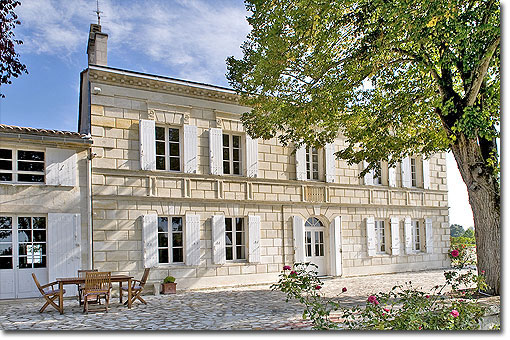
On the north bank of the River Dordogne is the newly renovated Château La Roque de Bas ~ a luxury weekly rental with a sparkling saltwater swimming pool, a fine tennis court and five luxury en suite guest rooms. Spend time in wine country while making this delightful château your home base. The château is the perfect venue for a small, intimate wedding or family gathering.
The
château
is in the prestigious Pomerol, Fronsac and Saint-Emilion region
northwest
of the city of Bordeaux. Visits to the famous vineyards producing
these wines are a stone's throw away, while a lovely day can also be
spent
on the nearby Médoc peninsula to enjoy the wines and vineyards
of
Graves, Haut-Médoc, Médoc, and other appellations.
Excellent gourmet cuisine is also to be throughout the region to
accompany
the wide variety of wines offered.
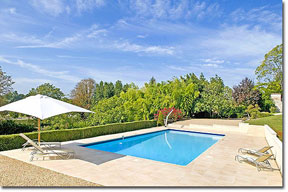
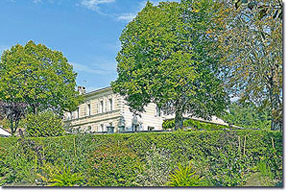
Those who enjoy hiking and cycling will appreciate the Fronsac region near the château for these pastimes as well as horseback riding and taking long country walks. It is a tranquil region with much to offer. Canoeing and kayaking on the Dordogne River should not be overlooked.
Be
sure
to visit Château La Roque de Bas
on our web site today to see the lovely rooms, the beautifully
maintained
grounds and the exceptional residence that you can rent for a week or
two
for your special Bordeaux area vacation.

Wine Appreciation Programs and
Tastings
at Member Properties
In the Loire ~ Please visit the pages on this web site of Château de La Barre in the Pays de la Loire region of northwestern France ~ your hosts offer theme weekends, and their expertise makes their wine appreciation weekend most enjoyable. Château du Breuil in the Loire-et-Cher will introduce you to the local Cheverny and Cour-Cheverny wines produced by the vineyards surrounding this beautiful chambres d'hôtes. Château de Reignac, offering fine wines and cuisine to their guests, is conveniently located for wine tastings at Montlouis, Bourgueil, Chinon, Saumur, and, of course, Vouvray and its vineyards on the right bank of the Loire. The history of growing grapes for wine in the Centre Loire region has its origins in medieval times, and AOC labels of quality include the wines of Pouilly, Sancerre, Menetou Salon, Quincy, Côteau du Giennois and others. Plan to stay at one of our newest members, Château de la Caillotière, a weekly rental château not far from Angers. Tastings of Loire Valley wines can be arranged for your group.
In Burgundy ~ Dinners at the magnificent Château de Villette in Burgundy are accompanied by carefully chosen regional wines such as Côte de Nuits, Côte de Beaune and Côte Chalonnaise. Château de Chorey, long-time producers of their own Côtes de Beaune wines, have sold their vineyards, but maintain their château and estate for bed and breakfast guests who will enjoy beautifully appointed and recently renovated en suite rooms with views over the vineyards.
In Provence ~ For those of you who are drawn to Provence, don't miss the opportunity to visit Château Juvenal, a warm and welcoming chambres d'hôtes not only surrounded by its own vineyards but olive groves as well. It is at Juvenal that you can sample both their wines and their wonderful olive oil! A stunning château wine estate, also in the Vaucluse, is Château Talaud and you can read more about it below on this page. When in Provence, you might also be interested in Le Pavillon de Galon, an exquisite residence offering spacious guest accommodations, occasional wine appreciation and cooking classes, and set amid the most beautiful gardens of native plants and spring-fed pools in the region ~ and now with its own vineyards and olive oil production!
In Languedoc-Roussillon ~ Château d'Agel, set among the vineyards of Languedoc in the Hérault département, produces its own wine and has a well-stocked shop up the road for browsing through the various offerings.
In the Rhône-Alpes ~ Experience the wines of the upper Rhône Valley with stays at Château de Chambost near gastronomic capital, Lyon, and the Beaujolais vineyards. And don't miss the unique and delicious regional wines of the Savoie offered at Château des Allues ,in the foothills of the Alpes near Chambéry, to accompany their lovingly-prepared dinners. A stone's throw from Château des Allues is the spectacular rental Château St-Philippe, a perfect venue for a wedding or family celebration. A wine producing estate a short distance from Lyon is Château de Longsard, whose French-American owners produce their own Beaujolais wines. Enjoy tastings at this luxurious B&B.
In Bordeaux
~ When
you are planning to tour the vineyards of the Médoc
Peninsula, you will want to be convenient to all the famous wine
estates of the region. For a Bordeaux wine experience you won't soon
forget, visit the luxurious
Château
Meyre on the peninsula. Award winning Margaux
and Haut-Médoc wines are produced on the estate, and the
accommodations
for guests are exquisite. Off the Médoc Peninsula you can rent a
château: Château Lagorce,
which is large enough to accommodate more than 40 people in over twenty
en suite guest rooms, near Bordeaux and St-Emilion for visits to
vineyards
and wineries, and convenient to the city of Bordeaux, local historic
villages,
the Atlantic Coast, Arcachon and more!
by Panos Kakaviatos
Should
Alsatian Riesling wine not be called Riesling?
According to Jean Michel Deiss, high-end wines from Alsace should follow the lead of other French wine regions and omit the name of the grape on their label, all in the name of terroir, but other winemakers are crying foul. Enologist Marie-Hélène Christofaro just finished a phone call to a sommelier in a Cote d’Azur restaurant, explaining why the wine she sent from Alsace had no mention of the grape variety.
“It’s a matter of education,” she said. “People are beginning to learn, and then they appreciate it.”
Christofaro works for Marcel Deiss in Bergheim, one of the top wine producers in the northeastern French wine region of Alsace, historically known for wines named after the grape varieties – and not after the places where the grapes are grown. Although wines named after grape varieties, or varietals, are common in what professionals call New World wines — from places like California, South Africa, Chile and Australia — most French wine regions, from Bordeaux to the Loire Valley, name their wines after place names, stressing what the French call terroir over the grape, or grapes, used.
“And, it is high time that all of us in Alsace do that too,” says Jean Michel Deiss, the forty-something owner of the 27-hectare domaine, always dressed in blue overalls, and always using mystic terminology to defend his technically illegal practice of not putting the name of the grape – be it Riesling, Gewürztraminer or Pinot Gris – on the labels of his Alsatian wines.
Harking back to the religious origins of winemaking in Alsace, Deiss compares each of his vines to ascetic Benedictine monks attempting to reach spiritual heights in just the right plot. But his monkish vines have more than just nature to contend with: the national French wine appellation authority, INAO, has specific rules for high-end wines in Alsace known as grand crus – or wines grown from particularly good locations.
First, only three grape varieties can be grown in grand cru vineyards (Riesling, Pinot Gris and Gewürztraminer), and second, the name of the grape must be on the label of any given grand cru wine.
“What Marcel Deiss is doing is totally illegal,” says Pierre Trimbach, winemaker for Maison Trimbach, another highly rated Alsatian winery, who, like many others, oppose Deiss’s crusade.
“It’s of course a question of style,” says brother and manager Jean Trimbach, “but it is impossible to adapt that to Alsace entirely.”
“Why oppose the grape variety against the terroir? When I drink an Alsatian wine, I would like to know first and foremost what I am drinking,” Jean Trimbach explains. “Even at a restaurant, I would like to know the grape variety so that I could know what to order with it…”
But Deiss insists, and the law has been looking the other way. Go into any wine store, from nearby Strasbourg to Washington DC, and you can buy a Marcel Deiss wine from Alsace, whose colorful label with medieval-like scenes and calligraphy mysteriously leaves out the grapes used to make it.
“We are left alone because we have formally asked the INAO to change its rules, and it’s under consideration,” Deiss says.
But who are “we”? According to Olivier Humbrecht, a winemaker internationally known for the quality of his Zind-Humbrecht wines, Deiss only has a handful of small vineyard owners who support him.
“I never paid much attention to what he was doing, but now I want people to know: it is ridiculous,” Humbrecht asserts.
“The only reason one would want to mix grape varieties is to correct an error,” says Humbrecht, who is known to have some of the finest wine plots in all of Alsace, where he grows 100% single varietal wines.
“Alsace is all about the purity of the grape. A Riesling wouldn’t be a Riesling if you started adding other varietals in the mix,” he explains.
 Deiss
counters: “What kills terroir today is the délire de la
pureté,
French for “the obsession with purity.” To him, one grape variety
is just one syllable.
Deiss
counters: “What kills terroir today is the délire de la
pureté,
French for “the obsession with purity.” To him, one grape variety
is just one syllable.
“How can you write poetry with just one syllable?” Deiss also claims that by co-planting different grape varieties in one plot, they tend to ripen at the same time – an argument Zind-Humbrecht finds crazy.
“I tell you, we tried that many years ago, and when the Riesling is ripe, the others are green, and when the others are ripe, the Riesling is spoiled. We’ve tried it and it does not work,” he countered.
Another respected winery, Albert Mann in Wettolsheim, also disagrees with Deiss.
“We are going to declare co-planting illegal in Hengst [a well-known vineyard in Alsace],” said Albert Mann winemaker Jackie Barthelmé, for the same reasons.
But the fact remains that the most highly rated – and most expensive – Marcel Deiss wines are all grape blends grown from the same plot, such as Schoenenburg or Altenberg de Bergheim, both grand cru vineyards. International wine critic, Robert Parker, gives notes in the mid 90s (out of 100) to both, which are composed mostly of Riesling, but including Gewürztraminer and Pinot Gris, each costing about $60 a bottle.
“In all fairness,” admits Humbrecht, “only time will tell how well his wines age.”
“So in say, 20 years, if his wines turn out really fabulous, then maybe we will all adapt his methods.”
“But I would not bet on that.”
Visit Domaine Marcel Deiss in Alsace at 15 Route de Vin, Bergheim, France. Phone: 33 (0) 3 89 73 63 37
For information about the author, please see the bottom of this web page.
[Photo
credit of Jean-Michel Deiss: http://www.mfandw.com]
A Classical Château in the Vineyards

We invite you to visit Château Talaud. The setting is superb if you are seeking a warm and inviting place to stay among the vineyards of Provence. In the sunny climate of southern France you will be able to visit the vineyards and villages of Châteauneuf-du-Pape and Beaumes de Venise, as well as the vineyards producing Côtes du Luberon, and have the exceptional pleasure of living among Château Talaud's own Côte du Ventoux vineyard.
This
beautiful
château, dating from 1732, offers guests exquisite rooms and
suites
(decorated by Conny Deiters-Kommer, your hostess) a unique
swimming
pool and the opportunity to learn more about the growing of wine grapes
in Provence. 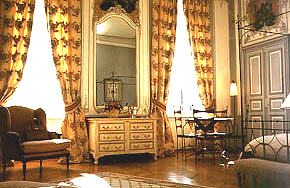 Hein Deiters-Kommer, your host at Château Talaud, is the
vintner.
He is understandably proud of the estate's thirty hectares, fifteen
(thirty-seven
acres) of which are planted in vines. The view over the vineyards
from the dining room and the opportunity to enjoy wines from the
château's
exceptional cellar add to the pleasure of your visit. Another
advantage
of staying at Château Talaud is the international atmosphere
created
by the owners who are world travelers. Six languages are
spoken
-- Dutch, English, German, Spanish, Russian and, of course,
French
-- every visitor will feel right at home!
Hein Deiters-Kommer, your host at Château Talaud, is the
vintner.
He is understandably proud of the estate's thirty hectares, fifteen
(thirty-seven
acres) of which are planted in vines. The view over the vineyards
from the dining room and the opportunity to enjoy wines from the
château's
exceptional cellar add to the pleasure of your visit. Another
advantage
of staying at Château Talaud is the international atmosphere
created
by the owners who are world travelers. Six languages are
spoken
-- Dutch, English, German, Spanish, Russian and, of course,
French
-- every visitor will feel right at home! 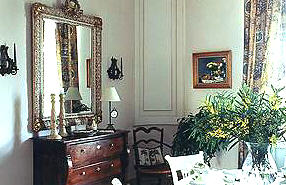
Château
Talaud is in the heart of the Vaucluse -- Avignon, Carpentras,
Arles,
Nîmes Aix-en-Provence, Saint-Rémy-de-Provence
(Wednesday
market), Les Baux de Provence, Marseille, Orange, Gordes,
Vaison-la-Romaine,
Isle sur la Sorgue (famous antique markets and fairs at Easter and in
August)
are all within easy reach. Château Talaud makes an
excellent
base for visiting the most interesting places in Provence.
Roman ruins are abundant in this region, including the arenas at
Orange,
Arles and Nîmes, the dramatic Pont du Gard, Glanum near
Saint-Rémy
de Provence and others.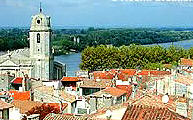
For wine lovers, this is wine country! The variety and abundance of wine results in excellent wine lists in local restaurants offering a wide choice of Rhône and Provençal appellations. And the opportunity for dégustation (tasting) the exceptional wines of the region are endless.
Château Talaud is open eleven months of the year to warmly welcome guests. The château glimmers in the Provençal sunlight, its manicured gardens perfect for quiet strolls, and its guest rooms cozy and comfortable. To visit Château Talaud on our web site for more photos and information about becoming their guest, simply click here. Reservations can be made by a click on their email address or by sending a Fax to the number on their page. The Deiters-Kommers are ready to welcome you to their estate and are waiting to hear from you!

Luxury Accommodations at a Bordeaux Wine Domaine
Château
Meyre offers the comfort of a château chambres d'hôtes
along with
the
opportunity
to experience first-hand the art of wine making
at
a
beautiful and noteworthy Bordeaux wine domaine.
Château Meyre couldn't be more appealing! For those interested in the incredible Bordeaux wine country, the location on the Médoc peninsula is perfect, not just for a long stay but perhaps for visits to Margaux and St Emilion vineyards, lovely cycling trips on the peninsula or pleasant drives to the nearby Atlantic coast for dinner at the beach!
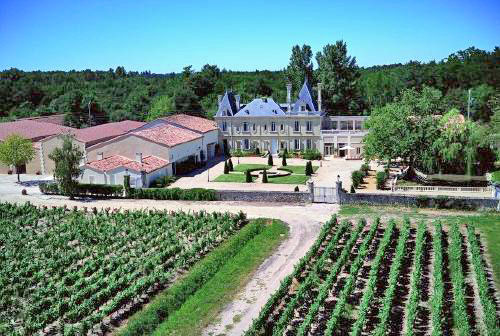
"The winemaking is traditional at Château Meyre, but the innovative owners do their own international distribution/marketing and have established a successful wine-tourism destination," wrote one wine expert not long ago.
Their
enologist,
Eric Boissenot, is overseeing the production of some exquisite
wines.
Their tasting rooms offers visitors and guests alike the opportunity to
sample these fine appellations and purchase those that appeal most.

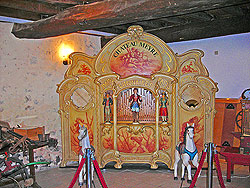
The
tasting
room at Château Meyre
Check
out the wines at http://www.chateaumeyre.com
and accommodations at the beautiful Château
Meyre on this web site with just a click on the name.
You will not be disappointed if your next Bordeaux stay is at
Château
Meyre!

The following article appeared in an issue of the newsletter FRANCE On Your Own
-- the first in their new column, French Wine Report. We hope you enjoy it and will try to
pay Château Léoville Barton a visit on your next trip to the Bordeaux region of France.
by Panos Kakaviatos
Anthony Barton is exhausted, and slightly upset. At 72 years old, he just finished his 50th wine harvest at his 45-hectare (112.5 acre) wine estate in Bordeaux bearing his family name, Château Léoville Barton, a highly-rated Bordeaux red wine in the commune of Saint Julien.
“Why can’t journalists just wait,” he complains about an article from the latest issue of the UK wine magazine, Decanter, reporting a poor 2002 harvest. “The article was written three weeks ago, and it has been published as if it is up-to-date news, “ says the Irish winemaker whose family constitutes a Bordeaux dynasty stretching back to 1725.
“The level of fruit concentration for this vintage has turned out exceptional, “ he claims, filling a glass with the recently fermented wine drawn from one of his oak casks, “which proves that it is better to wait until after the harvest before drawing any conclusions.”
Recent press has focused on how the Merlot grape suffered from uneven growth and bacteria, due to an uneven flowering, along with cold, damp weather in much of the summer. But Barton, like other chateaux owners in Saint Julien at least, emphasizes the warm month of September which led to fine maturity for the Cabernet Sauvignon grape.
No, he is not talking about two different wines. Bordeaux wine has always been a blend of grape varieties now found all over the world. His Léoville Barton, for example, is a blend of 72% Cabernet Sauvignon, 20% Merlot and 8% Cabernet Franc. Considered by connoisseurs to be among the top twenty wines out of thousands in Bordeaux, Château Léoville Barton retails for upwards of 60 euros per bottle.
“People often say that Saint Julien wines represent the quintessence of what a fine Bordeaux should be, “Barton explains. “ Finesse and elegance, yet also power and structure.” The richness of the wine at Léoville Barton is matched by the Barton family's long and eventful ties to Bordeaux.
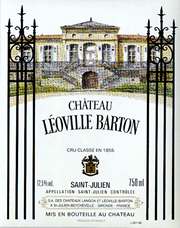
Barton
calls
himself a bog frog. “That term I suppose defines my background: a
mixture of the bogs of Ireland and the frogs of France,” he explains.
Thomas Barton began buying and shipping wine from Bordeaux in 1725. His grandson, Hugh, further developed the family holdings, including the purchase of the current château, but was thrown into prison by French Revolutionaries in 1793, because he was a foreigner.
Ronald Barton, Hugh’s great grandson, fled before invading German troops arrived in 1940. When General de Gaulle made his famous call to arms, Ronald’s request to fight with the Free French was refused, because he was a foreigner. He subsequently fought as a liaison officer between the British and Free French forces in North Africa and was awarded the Légion d’Honneur and the Liberation Medal.
Anthony Barton represents the eighth generation. Born in what was the family home, Straffan House in Kildare, Ireland, he went to France at the age of twenty to work with his uncle Ronald in the wine business.
To celebrate the end of the 2002 harvest, he and his Danish wife Eva invited 120 guests, including the grape pickers, to lunch at his château, a classical, single-story 18th century chartreuse with impeccably kept English-style lawns and gardens, flanked on both sides by wine cellars and offices.
“The harvest reminds us that people in the end make wine, and we were very happy to have given a medal to one grape picker who has been with us for his 30th harvest, “ Barton says. Optimistic about 2002, he opens a bottle of 2000, a vintage which has been universally praised, to celebrate. Such a bottle is priced at about $130!
“Santé,” he says lifting his glass, and quickly adds “Slainte” [pronounced shlanté] – Gaelic for “to your health.“
Should you wish to visit the château and try some of the wine during your stay in France, please contact Château Léoville Barton, 33250 Saint Julien Beychevelle, France by mail or from outside of France by Fax at 33.5.56.59.14.29, by Phone at 33.5.56.59.06.05 or by email at chateau@leoville-barton.com.
For information about the author, please see the bottom of this web page.
For
future
articles in the Frence Wine Report, or to learn more about
the
on
line newsletter for independent travelers to France,
FRANCEOn
Your Own, visit their web site at http://www.franceonyourown.com.
Uncorked!
Vous vous demandez peut-être pourquoi depuis quelques temps les bouchons synthétiques ont remplacé la plus part des bouchons naturels en liège des bouteilles de vin.
La raison est en fait multiple:
La plus évidente aux yeux de tous est l'élimination des goûts de bouchons que le liège peut apporter au vin et qui est si frustrant, surtout lorsque la bouteille est spéciale. Une autre explication provient du fait que la production mondiale de liège est limitée, d'autant plus que ces dernières années, le Portugal qui en est le premier producteur, a été ravagé par des feux qui ont détruit une grande partie de ses chênes lièges.
Dans un même temps, la production mondiale de vins n'a cessé d'augmenter avec l'arrivée des vins du nouveau monde. Il a donc fallu trouver d'autres solutions pour boucher les bouteilles de vin.
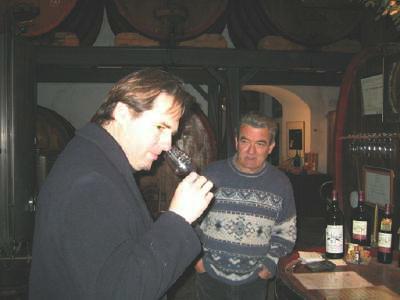 Mais
la raison principale provient de l'utilité même du
bouchon.
A l'origine, il permettait non seulement de boucher la bouteille mais
aussi
de permettre au vin d'être en très leger contact avec
l'air
et donc vieillir lentement dans les meilleures conditions. Il faut dire
que dans le passé (jusqu'au milieu des années 80), les
vins
étaient élaborés « à la dure »,
et il fallait attendre quelques années avant de pouvoir les
boire
et les apprécier à leur juste valeur. Le bouchon en
liège
avait donc toute son utilité. De nos jours, les habitudes de
consommation
de vin ont bien changé. On achète un vin à 19H00
et
on le boit à 19H30. Si cela est quelque peu
caractérisé,
il faut bien constater que les vins sont bus rapidement. Et pour cela,
il faut donc les élaborer de façon à ce qu'ils
puissent
être apprécié dans leur jeunesse. Ces vins sont
moins
concentrés, plus fragiles à l'oxydation et n'ont aucun
intérêt
à vieillir. Un bouchon en plastique, qui est presque totalement
hermétique, permettra alors au vin de garder toute sa
fraîcheur
et son fruit. Bien sûr, ce raisonnement n'est pas valable pour
les
grands vins de garde qui continuent à être bouchés
avec du liège.
Mais
la raison principale provient de l'utilité même du
bouchon.
A l'origine, il permettait non seulement de boucher la bouteille mais
aussi
de permettre au vin d'être en très leger contact avec
l'air
et donc vieillir lentement dans les meilleures conditions. Il faut dire
que dans le passé (jusqu'au milieu des années 80), les
vins
étaient élaborés « à la dure »,
et il fallait attendre quelques années avant de pouvoir les
boire
et les apprécier à leur juste valeur. Le bouchon en
liège
avait donc toute son utilité. De nos jours, les habitudes de
consommation
de vin ont bien changé. On achète un vin à 19H00
et
on le boit à 19H30. Si cela est quelque peu
caractérisé,
il faut bien constater que les vins sont bus rapidement. Et pour cela,
il faut donc les élaborer de façon à ce qu'ils
puissent
être apprécié dans leur jeunesse. Ces vins sont
moins
concentrés, plus fragiles à l'oxydation et n'ont aucun
intérêt
à vieillir. Un bouchon en plastique, qui est presque totalement
hermétique, permettra alors au vin de garder toute sa
fraîcheur
et son fruit. Bien sûr, ce raisonnement n'est pas valable pour
les
grands vins de garde qui continuent à être bouchés
avec du liège.
Enfin, le bouchon en plastique permet au marketing, élément devenu si important dans les aspects commerciaux, de s'exprimer notamment par le jeu des couleurs et par un marquage personnalisé beaucoup plus facile à réaliser.
Maintenant, si vous avez des bouteilles avec des bouchons plastiques qui traînent dans votre cave, vous pouvez sans hésitation allez en cherchez une et boire à ma santé.
. . . en anglais
You may ask yourself just why, for awhile now, synthetic corks have replaced most of the natural corks in bottled wine.
In fact, there are many reasons:
The most obvious reason of all is the elimination of the taste that cork can bring to wine ["cork taint"] which is so frustrating, particularly when the bottle is a special one. Another explanation comes from the fact that world production of cork is limited, especially these last few years, as Portugal, which is the leading producer, has been ravaged by fires that have destroyed a great part of these cork oak trees.
At the same time, world production of wines has not ceased to grow with the arrival of wines from the new world (North America, Chile, Australia, South Africa). So it was necessary to find other solutions for sealing bottles of wine.
But the main reason comes from the actual utility of the cork. Originally, it permitted not only closure of the bottle but also for the wine to be in slight contact with the air, and therefore age slowly and in the best conditions. It should be noted that in the past (up until the 80's), wines were made the hard way and it was necessary to wait a few years before being able to drink and appreciate them at their true value. The natural cork, therefore, had its usefulness.
Today, wine consumption habits have greatly changed. We buy wine at 7 p.m. and drink it at 7:30 p.m. If that's not such a typical scenario, then one should simply note that wines are quickly consumed. And for this, they must be made in such a way that enables them to be appreciated young. These wines are less concentrated, more fragile regarding oxidation and won't get better with aging. A plastic cork, which is almost completely hermetic, permits these wines to keep their freshness and fruity taste and will also better protect them from oxidation which might degrade them. Of course, this reasoning is not to be used for great wines (ones which should be aged) which continue to be sealed with real cork.
At last, the plastic cork enables marketing, an element that has become so important in commercial aspects, to express itself, notably by the range of colors and by a personal logo which is easier to create on the plastic cork.
Now, if you have plastic-corked bottles hanging around your cellar, you can, without hesitation, go and grab one and drink it to my health.
Cheers !
Jean-Marc
Jean-Marc
Espinasse is a French wine lover. Apart from formerly managing, along
with his uncle,
a
little
family vineyard in Chateauneuf-du-Pape, he is selecting "soulful wines"
throughout France,
Spain
and
Italy to offer to US wine importers. Today he owns and operates a
vineyad in Bandol
closer to his roots in Marseille. He is also educating people in
wine,
mainly in
corporate
companies but also in schools like the Wine MBA program in Bordeaux.
Visit
him at: http://www.mas-des-brun.com/
The
following
article appeared in an issue of the newsletter FRANCE On Your Own
in
their
column,
French
Wine Report. We hope you enjoy it and will try to
pay
Château
Raymond-Lafon a visit on your next trip to the Bordeaux region of
France.
Château Raymond-Lafon Exemplifies the Best of White Bordeaux
by Panos Kakaviatos
Red may be the color that comes to mind when one thinks of Bordeaux, but French wine journalists will gather January 22 in Paris to taste and judge the already legendary 2001 vintage of one of the finest white wines in Bordeaux: Sauternes.
For this sweet white Bordeaux variety, 2001 featured ideal weather conditions which allowed for the special mold called botrytis cinerea to concentrate grape juices just perfectly. Harvesters had a field day at Château Raymond-Lafon, one of the top Sauternes producers, which will be the appellation standard bearer at the Paris tasting this month.
“In 2001, we were able to pick our maximum yield, which will result in about 30,000 bottles, “ says Charles Henri Meslier, the château’s wine maker.
The entire Sauternes appellation includes some 6000 acres of vines in what is, arguably, the most beautiful of the Bordeaux appellations: gently rolling hills, foggy mist from the nearby Cerons stream, and a charmingly small and authentic town center.
Château Raymond-Lafon’s 50 acres are preciously located right near the world famous Château d’Yquem. Pierre Meslier used to make wine for d’Yquem from 1961 until his retirement in 1990; he bought Raymond–Lafon in 1972, and he and his family have ever since been responsible for making Sauternes wines approaching the quality of d’Yquem, at about one-third its price, according to American wine critic Robert Parker. French critics also laud the quality of this Sauternes, and the Swedish government selected Raymond-Lafon for its Nobel Peace Prize dinner in 2000.
The château will represent the Sauternes appellation at the January 22nd wine tasting in Paris, to include not just a 2001 barrel sample but celebrated vintages such as 1921, 1929 and 1949, as well as most vintages from the 1980s and 1990s.
A challenging wine to make...
At its best, Sauternes is famous for wines that are balanced in their sweetness with enough acidity and barrel aging to match the high levels of excess sugar that make Sauternes a sweet white. Many common Sauternes can be heavy in their sweetness, but châteaux like Raymond-Lafon produce wines that can only be described as elegant in their sweetness.
Such high quality Sauternes (a bottle of Raymond-Lafon costs about $60) are more difficult and costlier to make than red Bordeaux. Although the health and ripeness of the grapes are, in general, important, just as for red wines the adventure of making Sauternes only begins after the harvest for red wines. Workers run a greater risk of running into bad weather conditions as they have to make several pickings of only those grapes affected by the botrytis in October, November and sometimes even into December.
Marie-Françoise Meslier, who manages Château Raymond-Lafon, explains, “If you want to make a high quality red wine in Bordeaux, you are limited to one bottle of wine per vine. The maximum in Sauternes, however, is three glass of wine per vine. Here at Raymond-Lafon, we only produce one glass per vine.”
But,
sometimes that glass is very small, which was the case in 2000, a very
difficult year when only enough wine was fermented to fill about 10,000
bottles at the château. Indeed, because of the different
type
of picking involved, an easy year in Bordeaux for red wine may be a
difficult
year in Bordeaux for Sauternes, and vice versa. The recent craze
over the 2000 vintage is a good example: Robert Parker called it
Bordeaux’s vintage of the century — for reds. But the weather that year
deteriorated in October and did not much improve, so that only very
little
quality Sauternes was made in 2000, known as a difficult vintage for
Sauternes. 
No
need
to worry if you cannot attend the special Paris tasting on January
22;
the English-style ivy covered château, whose grounds include
peacocks
and exotic flowers, keeps its doors open to visitors seven days a week
throughout the year, including a free tour of the cellar followed by a
tasting.
Charles-Henri and Pierre Meslier
[Photo: Château Raymond-Lafon]
Wine lovers planning trips to Bordeaux should not miss a stop in Sauternes and Château Raymond-Lafon. Feel free to contact the Meslier family at famillemeslier@chateau-raymond-lafon.fr or phone them at 33.05.56.63.21.02 from within France.
For information about the author, please see the bottom of this web page.
For
future
articles in the Frence Wine Report, or to learn more
about
the
FREE on line newsletter for independent travelers to France,
FRANCE
On Your Own, visit their web site at
http://www.franceonyourown.com.
A Burgundian Retreat on 500 Acres
In the Morvan hills of western Burgundy is a remarkable estate of 500 acres and a château that will surely impress all who stay there. Château de Villette is a tranquil and refreshing oasis -- the ideal vacation spot -- for those seeking a quiet vacation or those eager to explore the myriad vineyards of Burgundy, the wine center of Beaune or the culinary offerings of Lyon or Dijon.

Château de Villette is a grand estate only sixty kilometers from Beaune. The beautiful and expansive parklands are accredited to the early work of André le Notre, famous for his designs at Chantilly and Versailles. Guests of the château will enjoy the formal gardens and terraces, century-old landscapes and trees, the streams and ponds that dot the estate and the lush, green forests. Perhaps most notable are the unending panoramic views.
The accommodations offered are in freshly redecorated rooms incorporating exquisite linens and fabrics, luxurious beds, furniture suited to the period and en suite bathrooms with all modern amenities. For those wise enough to choose dinner au château, they will discover incredible offerings from five menus, served by candlelight and accompanied by carefully selected wines -- the same wines found on the finest wine lists in France. These appellations are from nearby Côte de Nuits, Côte de Beaune and Côte Chalonnaise. Host and hostess, Coen and Catherine Stork, are understandably proud of their cellars housing wines they have personally selected for their quality and authenticity.
Do
visit
Château
de Villette on our web site at your next opportunity. You can
make reservations by sending us or them an email. You will not
regret
time spent at this exceptional Burgundian retreat!

We
understand
that there are many people visiting France who would love a guided tour
through the vineyards, stopping for tastings and receiving
knowledgeable
information along the way. Perhaps we have discovered just what
those
people are seeking! 
Pierre Galmes is an accredited chauffeur who is discreet, fluent in English, professional in every way and drives a sparkling clean, air-conditioned car -- and Pierre is a non-smoker. He has expertise in all important wine regions of France from the Loire Valley to the Rhône, from Champagne, Alsace and Burgundy to Bordeaux. Pierre helps his clients to discover all the famous places they have read about as well as equally wonderful places they may never have known. His inside information and ability to provide insight into the world of wine makes tours with Pierre rewarding experiences -- you could enjoy private tastings and meet some of the important people behind the production of France's greatest wines!
And now, Pierre has facilities for chauffeuring wheelchair users in the appropriate licensed vehicles, and he has identified hotels, restaurants, places of interest and hire vehicles for the wheelchair user (please access https://www.burgundy-driver.com/).
Details
of chauffeured tours are available from Pierre. He can provide
testimonials
from previous guests, a schedule of planned tours (his availability is
not limited to these), information on your safety and security while
traveling
with Pierre, and so much more. Do pay the site a visit! You
may find you have just discovered the ideal way to visit French wine
country!
The Riches of Provence's Château Juvenal
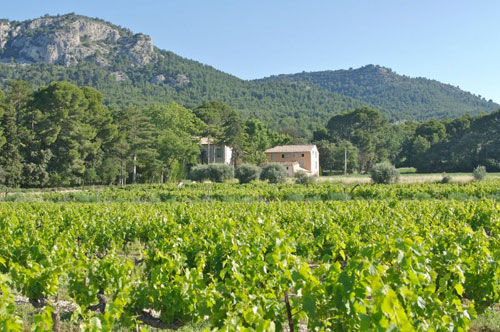
The Dentelles de Montmirail form the backdrop for an exquisite small château near Carpentras in Provence's popular wine country. Guests can enjoy beautiful rooms overlooking the park or the vineyards. Just down the road from the château are the newest vineyards and the winery where the Forestiers produce their ever more popular appellations. And, their olive groves are bustling with activity during harvest, and they yield absolutely amazing, delicious oils.
Le
Domaine
de Graveyron, part of the château estate, produces
rosé,
white and red wines. They have just received the
tasting
notes from Robert Parker (September 2013), and he wrote: "Made with
the consulting assistance of the inimitable Philppe Cambie, this 2012
La
Terre du Petit Homme comes from an up-and-coming treasure trove for
values,
the Côtes du Ventoux. A blend of equal parts Grenache and
Syrah,
with the Grenache kept on its lees in stainless steel and the Syrah in
new French oak, it exhibits lots of crème de cassis, blackberry,
acacia flower and camphor notes as well as a fresh, attractive,
medium-bodied
mouth feel with impressive purity, texture and length. The
tannins
are soft and unobtrusive. Drink this lovely red wine over the
next
several years." This wine was rated 90 out of 100.


Guests will not lack for things to do at Château Juvenal. The energetic owners, Anne-Marie and Bernard Forestier, offer cooking and painting classes, wine and cheese tastings, and tango lessons! It is hard to believe that they can find time to do so many things, but they do! And they do it all with great enthusiasm.
Whether you are interested in learning more about wine production, wish to discover the secrets of really fine Provençal olive oil, or just seek a friendly and welcoming chambres d'hôtes, you will be able to do all that and more as a guest at this marvelous château. Visit Juvenal, spend a few days in the warm Provençal sunshine and experience Provence at its most interesting!

The
following article appeared in an issue of the newsletter FRANCE
On Your
Own
in
their
column, French Wine Report. We hope you enjoy it and will
try the
wines
of Saint Emilion and visit the region on your next trip to France.
CHÂTEAU ANGÉLUS - Rising among the Bordeaux Elite
by Panos Kakaviatos
Perhaps the most traditional Bordeaux wine appellation, Saint Emilion, was a religious center during the Middle Ages – half of its 9,000 inhabitants were monks largely responsible for exquisite limestone architecture, which includes amazing underground passageways.
Declared
an historic monument by UNESCO in 1999, Saint Emilion is flooded by
tourists
each year. But anyone who takes a stroll on the town's
cobblestone
pathways cannot avoid its omnipresent wine boutiques, hilly vineyards
and,
when a vintner allows, wines stored in those old underground passages –
all of which reveal Saint Emilion’s more recent claim to fame: fine
wine. 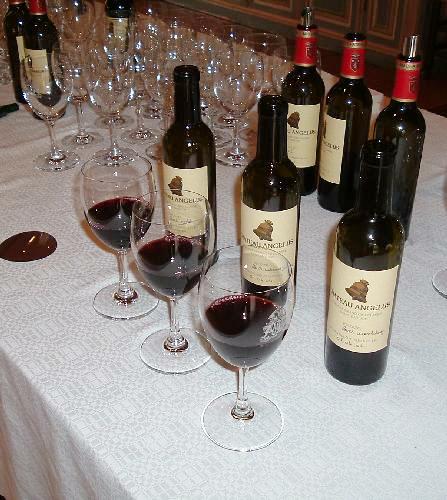
Wine writer Hugh Johnson advises people who want to discover Bordeaux wine to try Saint Emilion first, because the generally dominant Merlot grape in most Saint Emilion wines tends to be softer and more approachable that the Cabernet Sauvignon-dominated Médoc appellation, famous for such wines as Château Latour, Margaux, Mouton Rothschild and the like. Indeed, French sommelier Cécile Chauveau, who works spring and summer at the upscale Chanticleer restaurant on Nantucket Island, admits to bending the truth slightly in sometimes recommending Merlot-dominated blends from Bordeaux like St. Emilion to American customers used to softer, sun-soaked Cabernets from California.
As a wine appellation, Saint Emilion packs some 2,000 chateaux into just over 5,500 hectares (13,600 acres), which surround the town itself. Unlike the more established and much larger Médoc, whose top wines were graded by an 1855 classification based on terroir still in effect today, the wines of Saint Emilion face more intense internal competition, as their more recent 1954 classification is renewed every 10 years, based not only on terroir, but also on consistency in quality.
That
means that wines from any part of the appellation can be either
promoted
or demoted, and that includes the some 1,350 plain old Saint Emilions,
the some 600 Saint Emilion “Grand Crus,” the 55 Saint Emilion “Grand
Cru
Classés,” and, finally, the top 13, which are themselves divided
into two parts: Cheval Blanc and Ausone as the top two Saint Emilion
Grand
Cru Classés “A” and 11 Saint Emilion Grand Cru Classés
“B.”
One of the appellation's most highly prized wines – and rising stars in the higher echelons – is Château Angélus. Promoted into the top 13 in the last re-evaluation in 1996, there is talk that it may join Ausone and Cheval Blanc, if not in 2006, then in 2016. Most of the wine is exported which makes it, oddly enough, sometimes less expensive in the United States than in France, though prices on both sides of the Atlantic are hardly cheap. Reflecting the impeccable quality of the wine, an average vintage can cost up to $80 a bottle, with a great vintage, like 1989, fetching as much as $300 a bottle.
Less than a mile from the famous bell tower at Saint Emilion on its renowned south facing “pied de côte” (foot of the hill) site, Château Angélus is the story of four generations of the Boüard de la Forest family. The estate's name derives from an ancient vineyard, from which the men tending the vines could hear the angélus ringing out from all three of the town's churches: the Chapelle de Mazerat, the Church of Saint Martin de Mazerat and the Church of Saint Emilion.
At the turn of the century, Maurice de Boüard de la Forest acquired the then three-hectare plot (about seven and half acres), adding it to the adjacent vineyard, Château Mazerat, which had been in the family since 1850. Sons Jacques and Christian expanded the holding by buying adjoining plots of land, until by the 1970s, they had completed the property run today by Hubert de Boüard de la Forest and his cousin Jean-Bernard Grenié.

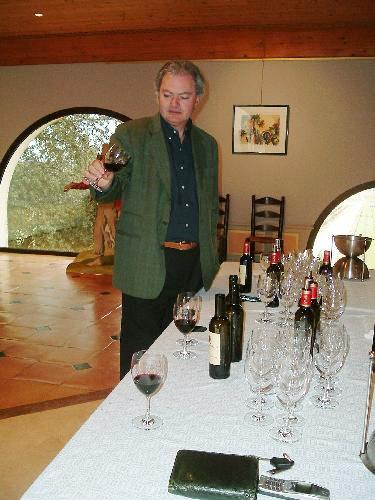
Hubert de Boüard de la Forest at a tasting of his Château Angélus wines
The promotion was the result of hard work from both de la Forest and Grenié. They introduced the philosophy of picking riper grapes, advocated by Emile Peynaud, the grandfather of modern French winemaking, who also taught de la Forest personally. Regrettably, Peynaud passed away this year, but his influence lives on today. Many winemakers, wine lovers and critics praise his approach and impact to winemaking, from Robert Parker to Hugh Johnson.
But beyond picking riper grapes, the owners also declassified grapes from lesser plots to make a second wine – something many châteaux do in Bordeaux – and have concentrated all the best plots for their Château Angélus blend, which includes a high proportion of Cabernet Franc, a grape that lends a mentholated freshness to their wine. The owners also keep up with technology while respecting traditional methods, so that each harvest and each vintage achieves as much as possible.
Recently in Bordeaux and then on Nantucket Island – during the 8th Annual Nantucket Wine Festival in May – I was able to taste the wine in both vertical and horizontal tastings. In wine lingo, a vertical means that one tastes several different years – usually contiguous – of the same wine, in this case Angélus. A horizontal means the opposite: tasting different wines, but from the same year.
While in Bordeaux during the primeur tasting of the latest 2003 Bordeaux vintage – the vintage is tasted roughly six months after the harvest, after having had some time in the barrel – I was impressed by the quality of Angélus in a vintage that was not most favorable to Merlot. It stood out among many of its peers in the horizontal tasting in late March.
Two months later on Nantucket, I hosted the vertical tasting for wine festival participants. The eight wines tasted, spanning 12 years, illustrated the consistent quality one obtains from this château and is explanation enough for its recent promotion. As follows, my brief tasting notes:
2001: Very young and tight – which is expected from a wine that was bottled less than a year ago. A very good if not great year. But put the bottle away, and wait for it to open up in about five years.
2000: All I could say was “Wow.” A very full-bodied and balanced wine, though still very young with hints of tannin that will melt over time. A great vintage overall in Bordeaux, and very successful for this château. Prices reflect this success, with this bottle fetching about $225 on today's market.
1998: Almost as good as the 2000, though more compact. Does not have the enormous aromatic qualities of the 2000 but still very good.
1996: Leaner than either the 1998 or the 2000, more similar to the 2001, but properly aged with a very smooth Cabernet Franc freshness to it that is appealing. Very well done.
1995: This wine was tasting no less than heavenly and upstaged all of the wines of the tasting, with the exception of the 1989. Full-bodied, yet nuanced, the wine's tannin has melted and the result is a balanced flavor that one will also obtain from the more recent vintages.
1994: Not the favorite among some of the wine tasters at the festival, I really enjoyed this wine for its mineral qualities and smoothness. It is certainly not as full-bodied as, say, the 1995 or the 2000, but offers fine taste.
1990: A great year in Bordeaux and a great wine. I thought it was tasting a tad stolidly at this stage, although it was lovely in aromas and flavor. When tasting wine, one must always remember that each vintage ages differently. The 1990 – a great vintage in Bordeaux – was among the very best of this vertical tasting, but will improve with time.
1989: This wine got my nod for best of the bunch along with the 1995. It was full-bodied, mature, elegant and packed with flavor.
The next time you go to Bordeaux, don't miss Saint Emilion and Château Angélus. A look at the well-done web site will give you more information about this exceptional château, which always welcomes visitors. You just need to call ahead. And, if you ever make it to Nantucket Island in May, check out the wine festival which features hundreds of wines from all over the world – in a wonderful setting!
Visit
these web sites for more on Château Angélus wines and the
recent tastings: http://www.angelus.com
and
http://www.nantucketwinefestival.com.
For information about the author, please see the bottom of this web page
[Photos
used
in this article are the copyrighted property of Panos Kakaviatos.]
The following article appeared in an issue of the newsletter FRANCE On Your Own
in their column, French Wine Report. We hope you enjoy it and will
try the wines of Saint Emilion and visit the region on your next trip to France.
FRENCH
WINE REPORT: Historic tasting and dinner at Château d’Yquem
by Panos Kakaviatos
Fireworks
lit the evening sky as privileged guests at Château d’Yquem
sipped
wine from the château's legendary 1967 vintage  during
a dinner for the press.
during
a dinner for the press.
As the wine served indicated - a 1967 bottle of this famous Sauternes can fetch up to $2000 - the dinner was no ordinary gathering!
On Sunday, June 19, the Conseil des Grands Crus Classés en 1855 launched Vinexpo, the famous biannual wine and spirits trade show in Bordeaux, with an exceptional celebration to mark the 150th anniversary of the classification of wines from the Médoc and Sauternes.
The world's wine press - some 200 journalists from 27 countries - attended the dinner, which was as much a social as it was a wine event, listed in the official list of 2005 “national celebrations” by the French Minister of Culture and Communications.
And what was all the fuss about? The 1855 classification was drafted as part of the presentation of Bordeaux's wines at the Paris Universal Exposition decreed by Napoleon III. The Bordeaux Chamber of Commerce entrusted the organization of the list to a brokers’ union attached to the Bordeaux Commodities Market.
As established connoisseurs of Bordeaux's wines, the brokers based their work on a century of statistical information, particularly price, which confirmed the finest terroirs of Bordeaux's Médoc and Sauternes wines to establish a list of properties which continues to be an authoritative reference - even though some properties today do not perform at the same level or have changed their vineyards.
The classification divided the very best wines of the Médoc – at least wines that earned the right to be on the brokers’ list – into five classes: from “first growth” at the top end to “fifth growth” at the bottom. The Sauternes that made the list were divided into first and second growths only, with Château d’Yquem above them all as a “superior first growth.”
Upon entering the château's hilltop courtyard on that warm Sunday evening, guests wearing tuxedos and gowns were greeted by Philippe Casteja, president of the Conseil des Grands Crus Classés en 1855, as a live orchestra played classical music. Tasty appetizers were served as winemakers and wine writers sipped recent vintages of top Sauternes (and Barsac) of first and second growth caliber such as Climens, Rieussec and La Tour Blanche.
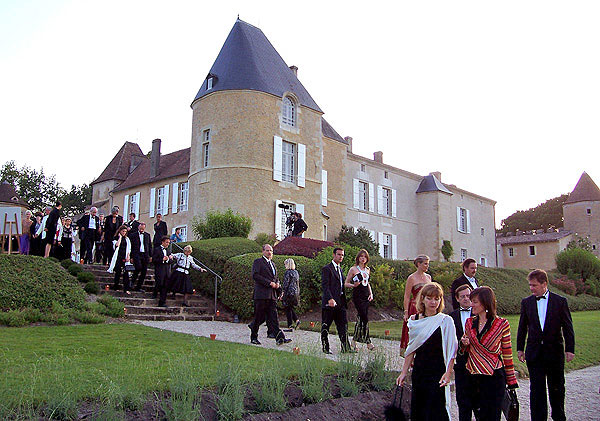
The food was fabulous, prepared by such well-known chefs as Ken Hom, Michel Guérard, and Michel Trama. But the wine proved unforgettable, with almost a half-century of great vintages served. Owners brought wines from their châteaux, so where I sat, we enjoyed two fine vintages of Léoville Poyferre: 1989 and 2000. But the cream of the crop came in the following order: a sleek and elegant Margaux 1983, an opulent and still youthful Mouton Rothschild 1982, a somewhat tired – alas – Lafite Rothschild 1979, a smoky though somewhat rough Latour 1978 and a very lovely tobacco-perfumed Haut Brion 1975 (in Pessac in what is knows as the Graves region of Bordeaux, Haut Brion was also classed first growth in 1855, the only non-Médoc wine to be included in the classification).
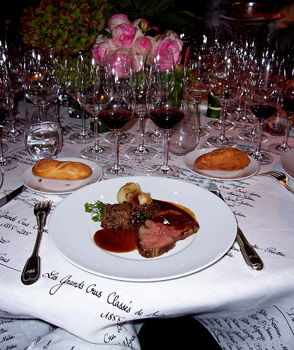
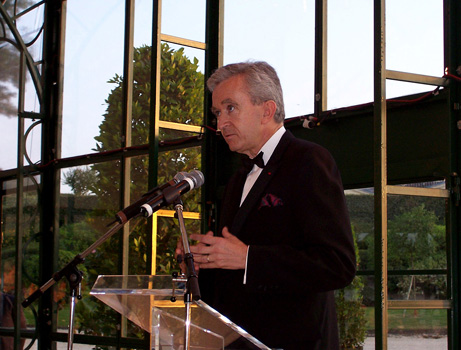
Philippe Casteja
President
Conseil des Grands Crus Classés en 1855
1, cours du XXX juillet
33000 Bordeaux, France
Telephone: 33 / (0)5 56 48 47 74
Fax: 33 / (0)5 56 79 11 05
Web site: www.grand-cru-classe.com
Château d’Yquem
Web site: http://www.chateau-yquem.fr
If you plan to visit Château d’Yquem, be sure to write them a
message
on their Web site at least three weeks in advance.
Hidden
gems
of Bordeaux: Château Guadet-Saint-Julien
by Panos Kakaviatos
Bordeaux does not just represent super famous châteaux from the Médoc and Sauternes! One can also discover domains on the Right Bank (Saint Emilion and Pomerol) with rich histories as well.
I discovered one such château in Saint Emilion: Château Guadet-Saint-Julien. Named after a revolutionary who lost his head in the Terror, the château makes traditional style Saint Emilion – not as big or rich as current fashion dictates, but rather elegant and fruity. Not included in the 1855 Classification, Saint Emilion has its own classification system, with two châteaux – premier grand cru classés A – at the summit (Cheval Blanc and Ausone) and 11 others are premier grand cru classés B.
Château Guadet-Saint-Julien is classed as one of the 55 grand cru classés.
 Current
owner Guy Pétrus Lignac has 5.5 hectares under vine (about 13.5
acres) and took the time during a break from Vinexpo to show me his
property,
located at the bottom of the main town of Saint Emilion on the
limestone
plateau.
Current
owner Guy Pétrus Lignac has 5.5 hectares under vine (about 13.5
acres) and took the time during a break from Vinexpo to show me his
property,
located at the bottom of the main town of Saint Emilion on the
limestone
plateau.
A charming garden space greets visitors to the château. To the left are four red concrete fermentation vats and a hydraulic press dating from . . .1919. Some 20 barrels used to age the wine (40 to 60 percent new oak, depending upon the vintage) are found to the right of the garden in a temperature-controlled chai. Lignac’s property includes underground limestone cellars to store the château's wines – including wines from his personal collection.
The wines of Château Guadet-Saint-Julien, made of about 75 percent Merlot and 25 percent Cabernet Franc, are generally fresh and fruity. At their best, they represent a fine alternative to the “big” and sometimes overbearing wines in fashion today. In lesser vintages, they can indeed be too light, at least for my taste.
Recent vintages tasted:
 2004
(barrel sample): Very violet color with fresh cherry and strawberry
aromas
and some vanilla coming from the oak. Palate is medium bodied and
corpulent,
with a nice texture. A bit tight on the finish but this is a barrel
sample.
Really fine wine.
2004
(barrel sample): Very violet color with fresh cherry and strawberry
aromas
and some vanilla coming from the oak. Palate is medium bodied and
corpulent,
with a nice texture. A bit tight on the finish but this is a barrel
sample.
Really fine wine.
2003 (just put in bottle two weeks earlier): Color is violet but not dark. Notes of white flower and spice dominate. A bit of a pinched sensation on the palate, due to the recent bottling. Otherwise, pleasant notes of cinnamon, cherry and plum emerge. Needs revisiting after some time in bottle.
2002: This wine had a clear red/violet color and was very fruit forward initially. Fresh strawberry aromas resembling a light Grenache-derived Rhône Valley wine. The palate was light in structure but pleasant.
2001: Initial notes of toast, some vanilla and then underbrush – very earthy and almost animal-like. Time in glass allowed the aromas to evolve – and the palate improved. More substance than the 2002. A fine Saint-Emilion.
1998: Youthful violet color. Cherry aromas and flavors. Fine and elegant on the palate, though a bit tight and somewhat alcoholic on the finish. Needs more time in bottle for its elements to come together.
Addresses and Contacts:
Guy Pétrus Lignac
Château Guadet-Saint-Julien
33330 Saint Emilion, France
Telephone: +33 / (0)5 57 74 40 04
Fax: +33 / (0)5 57 24 63 50
For information about the author, please see the bottom of this web page.
[Photos used in this article are the copyrighted property of Panos Kakaviatos.]
The
following
article appeared in the first on line edition of the newsletter FRANCE
On
Your Own
in
their
column,
French
Wine Report. We hope you enjoy it.
Placido
Domingo, Catherine Deneuve and Others
Celebrate
at Château Mouton Rothschild
by Panos Kakaviatos
Gala dinner at Chateau Mouton Rothschild and “collectors’ vintages” tasting in St. Emilion highlight Vinexpo 2003
Some1,800 guests came to Château Mouton Rothschild – including Bernadette Chirac, wife of French President Jacques Chirac, and Claude Pompidou, widow of late French president Georges Pompidou – to enjoy a festive dinner party, known as the Fête de la Fleur, on the last day of Vinexpo.

Opera tenor, Placido Domingo, sang live on stage, surprising everyone with operatic songs over a sumptuous feast featuring the mythical 1982 vintage of Mouton Rothschild among other fine wines.
Gathered in tables of twelve under a colorfully lit and immense tent-like metal structure, guests were treated to an ambiance resembling the Cannes film festival, with noted cinema stars such as actress Catherine Deneuve and actor Jean-Claude Brialy turning up for the party held by Mouton Rothschild owner Baroness Philippine de Rothschild, herself a former actress.
The Commanderie du Bontemps, a brotherhood grouping Médoc, Graves, Barsac and Sauternes, has organized the Fête de la Fleur annually in Bordeaux since 1952 to celebrate the vine flowering in anticipation of the autumn harvest -- but the party also marked two special anniversaries.
Duringthe dinner, a short film about Mouton Rothschild’s history was screened to mark both the 150th anniversary that Baron Nathaniel de Rothschild of the family's English branch bought Château Brane Mouton and renamed the vineyard located in the heart of the Médoc, as well as the 30th anniversary that Château Mouton Rothschild was promoted as one of the top five “premier cru” wines in an otherwise rigid 1855 classification of top Bordeaux wines.
After the film, the Baroness asked guests to turn their menu to the page including words to a song called “the hymn of Mouton,” announcing that the double anniversary was the perfect occasion to sing that song.
“But who will sing it?” she asked rhetorically.
As some diners – at least at my table – fought tooth and nail for every last drop of the 1982 Mouton Rothschild, a perfect 100 points on the Robert Parker scale, lush red curtains behind the Baroness rose and Placido Domingo, who had just flown in that afternoon from London, burst into song.
“I’ve been going to these sort of outings for the past 50 years, and I’ve never been to one as impressive as this,” proclaimed a dapper Anthony Barton of Château Léoville and Langoa Barton.
And impressive it was.
To begin, special buses drove guests to the château from the small river front of the Pauillac village. Upon arrival at 7 PM, the wine world’s elite, such as international wine consultant Michel Rolland and Sommelier of the Year, Marcus del Monego, mingled and sipped champagne as the Commanderie du Bontemps opened its ranks to some prestigious new members in a formal ceremony: British Ambassador to France Sir John Holmes, Asahi Brewery chief Shigeo Fukuchi, the head of the Daewoo group Kyunghee Lee, and Chanel general manager Marie-Louise de Clermont-Tonnerre.
Dinner began promptly at 9 PM, and guests enjoyed a starter of asparagus, truffles and white lake perch with herbs, followed by a duo of veal with delicate vegetables, fine cheeses, and, finally, a dessert of verveine sorbet and cooked peach with caramel. As if all that were not enough, fireworks lit up the sky at midnight, followed by disco music for guests to dance on stage.
One small caveat perhaps: while four of the five wines served are proven giants, one was more controversial.
A white 1999 Château Haut Brion started things off, whose 14% alcohol surprised most because the wine was delicate, balanced and extremely fine; the 1996 Château Margaux (99 out of 100 points on the Robert Parker scale) was aromatic and silky, if perhaps too young; the 1982 Mouton Rothschild lived up to its reputation, balancing elegance and power, with a long, long finish. The meal was capped with an honorable Château Coutet 1989 from Barsac, a stellar vintage in that region.
But some did not approve the choice of serving a Pauillac Baron Nathaniel 1999, one of the Rothschild’s many trade wines, just after the Haut Brion.
“What is that doing here?” complained one person.
Sommelier del Monego praised the choice however.
“It
was logical because dinners like this rarely showcase trade wines,
which
are an important part of Bordeaux sales, and because it was Baron
Nathaniel
who bought the château 150 years ago,” he said.
A violent storm marred dinner, but not the gathering, for extraordinary “collectors’ vintages” in St. Emilion
Just two days earlier, the top classified growths of Saint Emilion, the famous Bordeaux region generally dominated by Merlot, scheduled their own gala dinner at Château La Gaffelière, one of only 13 “premier grands crus” there.
Despite a massive and sudden storm, which drove the 130 guests that evening into the château’s cellar, the wines tasted [see list] lived up to their stellar reputations.
During
each Vinexpo week since 1989, the very top St. Emilion
châteaux
organize a dinner of “collectors’ vintages,” featuring rare and
legendary
wines from yesteryear. This year, they invested some 110,000 Euros to
prepare
two fairy-tale like tents at Château La Gaffelière
for the dinner, prepared by Philippe Capdevielle, one of Bordeaux’s
most
highly rated caterers. Staff worked twelve consecutive days,
weekend
included, to set up the décor, with careful attention paid to
the
layout, lighting and table settings. 
The menu included some of the finest cuisine to match the illustrious wine list, such as foie gras, truffles, eel medallions, lamb with fine herbs, a millefeuille of vegetables with spice, cheeses and a dessert of strawberry and macaroons - known for their quality in St. Emilion - and an original olive oil ice cream.
But fate had other plans: while guests enjoyed their 1988 Dom Perignon champagne apéritif outside the château at about 9 PM, the sky turned unusually dark, followed by hail, rain and havoc, just as guests were entering the tents...
In
less
than one hour, the storm wiped out not only the hard work put into that
dinner, but also knocked down some 6,000 hectares of vines in the
entire
Bordeaux region, mostly in Entre-Deux-Mers. The next day, one of the
guests,
Pascal Delbeck of Château Belair, said that the storm seriously
harmed
parts of his premier grand cru vineyard. 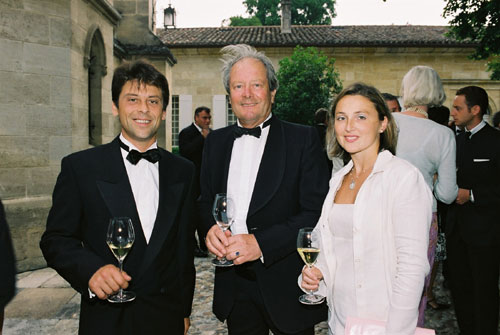
“I’ve never seen anything quite like this,” said celebrated wine writer Steven Spurrier, waiting inside one of the château’s halls with the other guests, wet and confused.
But improvisational ingenuity saved the evening.
Much of the food was lost, left underneath the tents, but the wines were safe and sound in the château’s cellar, to which the guests were led.
On the way there, some of the guests, including the elegantly dressed Juliette Bécot of Château Beau-Séjour-Bécot, helped staff mop away water in the vat room, to prevent anyone from slipping on their way downstairs to the cavernous, oak barrel-filled cellar, now lit with candles for the improvised gathering.
“It turned out to be a lot of fun,” said Charles Chevallier of Château Lafite Rothschild. “Before, we would have been seated at our own respective tables, but in the cellar, we were able to circulate and mingle.”
Perhaps
the only problem was that the wine’s drinking order – designed for a
carefully
planned dinner – was maintained for only bread and cheese, so drinking
the brilliant Château Cheval Blanc 1982 after the much older (and
far less tannic) Château Trottevieille 1953 perhaps made the
Cheval
Blanc taste harder than it should have.

Many
agreed
that the Château Figeac 1961 shined brightest that evening;
Joshua
Greene, publisher of the American wine guide Wine and Spirits,
for
example, said it was “simply the best.”
Meanwhile,
other wine writers like Olivier Poels of the French wine magazine La
Revue du Vin de France, noted that each of the bottles varied
in taste, leading to nuances discovered in different bottles of each of
these collectors’ vintages. 
Both Château La Gaffelière and Château Mouton Rothschild are open for visits. All you have to do is call ahead of time, and a tasting and visit will be organised for you. Château Mouton Rothschild: 33 5 56 73 21 29 and Château La Gaffelière 33 3 57 24 72 15.
[Collectors’ vintages: Château Pavie 1998, Château Beausejour Duffau-Lagarrosse 1990, Château Magdelaine 1989, Château Angelus 1989, Château Beau Sejour Bécot 1971, Château Canon 1970, Château La Gaffelière 1966, Château Belair 1964, Château Figeac 1961, Château Clos Fourtet 1959, Château Trottevieille 1953, Château Cheval Blanc 1982.]
For information about the author, please see the bottom of this web page.
[Photos
used
in this article are the property of the respective châteaux or
Groupement
de 1er Grands Crus
de
Saint
Emilion
-- to determine photo credits, please pass your mouse over the photo.]
Guide & Wine Books:
Michael S. Sanders, author of the recent From Here, You can't See Paris and The Yard, spent a few years with three families who produce Cahors wines, and his book is a fast-paced and interesting account not only of his introduction to this very good wine, but of the warm welcome he received by these wine producers who permitted him a personal glimpse of their family life and histories, explained their theories about what they believe wine is all about, and let him in on what is really involved in their day-to-day lives to produce the best wine they can. To quote the author, "In the lives and minds of the winemakers themselves, too, there is little of the exotic or romantic in what they do, or even in the way they think. Seen through their eyes, wine is not a mystery or an elixir reserved for members of the inner temple, but a product wrung from the earth by honest labor."
The author chose a secondary wine producing region ~ the region around the River Lot in southwest France away from the vineyards and châteaux of Bordeaux or the golden slopes of Burgundy. It was here he would learn to love the wine itself ~ Cahors, the 'black wine' of France ~ a wine he says has 'escaped Parkerization', referring to wine critic, Robert Parker, of course.
Sanders takes us on a discovery tour of the Cahors winemaking business from the viewpoint of the vintners each intend to maintain a strong link to their history and tradition. We follow them through the interesting and the mundane: grape-picking schedules, crises of weather, fertilization of vineyards without chemicals, measuring the sugar levels of grapes still on the vine, and eventually the harvest leading to winemaking itself as fermentation and maceration begin. Sanders provides a concise history of Cahors wine which began with the city of the same name some 2000 years ago, established by Celts ~ the Cadurcians ~ hence the name.
[Families
of the Vine: Seasons Among the Winemakers of Southwest France
by
Michael
S. Sanders is published by Harper Collins and available in April 2005.
ISBN
0-06-055964-0
$24.95 US / $34.95 Canada]
The book, inspired by a story told to the authors by the Loire Valley's Gaston Huet, Wine & War takes us from Huet's capture and five-year internment as a prisoner of war through the daily struggles of many wine makers to protect their valuable vintages from being confiscated ~ so they would at least have some stock on hand at war's end. Their livelihoods depended upon it, but the deep desire to protect a symbol of France also had a part to play. The authors began to interview wine makers to collect their stories. Although some didn't want to recall a time when there were those who collaborated with the enemy, others were more than willing to tell of heroic, sometimes funny, tales about wine and its relationship to the war. And, there were obstacles for the authors as some records about collaborators are sealed under French law to protect the privacy of individuals, other information was destroyed by the German high command, people they planned to interview passed away, and still others had fading memories and didn't feel they could contribute anything.
To read the full review of this book, please visit FRANCE On Your Own's December 2005 newsletter.
[Wine
& War - The French, the Nazis & the Battle for France's
Greatest
Treasure by Don and Petie Kladstrup
is
published
by Broadway Books, a division of Random House ISBN 0-7679-0447-8
US $24 / CAN $35]